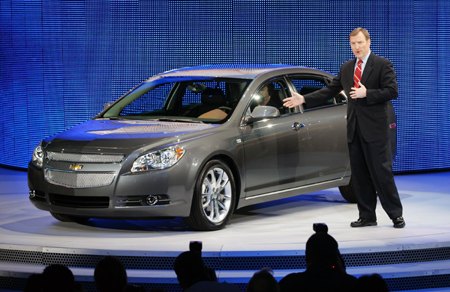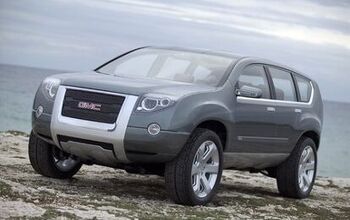General Motors Death Watch 138: The Big Picture
"We anticipate [that the U.S.] will still be the most profitable market in the decade ahead. It's really key not to be excessively dependent on the U.S., but you still need to be successful in the U.S." It’s no surprise that GM Chief Sales Analyst Paul Ballew sent mixed messages to the financial community when revealing GM’s Q2 sales results. Not to put too fine a point on it, the automaker’s U.S. market share continues to evaporate while its overseas operations continue to expand. The General’s growing foreign sales aren’t enough to compensate for the company’s North American sinkhole, but it gave GM’s spinmeister something to spin. Such is the way of things at GM these days.
That said, this just in: according to Mr. Ballew, GM should begin seeing a recovery in U.S. in 2008. As far as I can tell, no reporter or analyst asked GM’s mouthpiece what events or non-events are covered by the word “should,” what exactly the word “recovery” means, when in 2008 this recovery will arrive or how this sudden rise from GM’s fall from grace will be achieved. Oh, and didn’t GM say they were already in recovery?
Yes, well, it’s no wonder GM’s backed away from that idea. Thanks to a spectacularly lousy June, this financial quarter, at the height of GM’s new product cadence, the automaker’s North America sales fell seven percent. Once again, GM blamed high gasoline prices, a weak housing market and a planned reduction in daily rental sales. So are we to assume that gas prices will decline, the housing market will jump to its feet and the company will abandon abandoning daily rental sales?
The last point raises an important question. It’s all well and good to bolster residual values by limiting fleets sales, but what will take the place of these job lots and raise GM NA out of its current torpor? The new Saturn Astra, whose production and importation costs obviate the possibility of profit? The new Chevrolet Yukon hybrid, an enigma wrapped in a riddle (what kind of fuel conscious buyer buys a huge, poorly packaged SUV)?
How about the new Chevrolet Malibu? Last year, the current fleet queen Malibu racked-up 153,846 sales. If GM is getting out of the fleet business, they’ll need to replace every Malibu removed from fleet duty with one purchased by a retail customer. In other words, Chevrolet will have to sell tens of thousands more Malibus to retail customers just to achieve existing volumes.
The redesigned Cadillac CTS is also on the horizon. Last year, GM’s erstwhile luxury division unloaded 54,846 CTS sedans on its class-conscious customers. Even if Caddy doubles that total, it still wouldn’t generate anywhere near enough profit to rescue a company with eight brands selling 52 models.
Clearly, obviously, GM’s turnaround depends on the company shifting a lot more of everything. While there are some bright spots and heavy hitters in GM’s roster– the law of averages guarantees it– the overall picture is bleak. Other than reducing price, which kills profits and destroys brand equity, what can they do?
Rick Wagoner’s mob doesn’t have an answer. Thankfully (for them), no one’s asking. All eyes are now upon GM’s negotiations with the United Auto Workers (UAW). Wall Street, stockholders and GM camp followers are all watching the proceedings like hawks, presuming that reducing labor costs to transplant parity is the key to GM’s survival. That logic only works if you assume that GM would use the money saved to make better cars. Is there anyone out there who really believes that?
At the risk of sounding cynical (perish the thought), any money saved is likely to disappear down GM’s corporate rat hole. For one thing, if GM bosses pay themselves huge bonuses when the company’s losing billions, imagine what they’ll do after concluding a “historic union giveback.”
Whether or not GM “reduces” its health care obligations by going into subterranean levels of debt (to set up a VEBA for the UAW as described by Frank Williams), whether or not the two sides emerge from negotiations with the status quo intact or destroyed, Chevy and Saturn will still be fighting a losing battle against Toyondissan, Cadillac will still be struggling for sales, Pontiac and Buick will still be deeply damaged brands, Hummer and Saab will still be expensive irrelevances and GMC will still be… there.
Now that GM’s suffered a 24 percent sales drop in June against the transplants’ double digit sales increases, some analysts are beginning to understand the crux of GM’s problem: unloved, unwanted and uncompetitive product. If GM’s sales take another big hit in July while their competition moves upward, there will be even more pressure to do a deal with the UAW. And it will be even more irrelevant.
More by Robert Farago
Latest Car Reviews
Read moreLatest Product Reviews
Read moreRecent Comments
- Alan My view is there are good vehicles from most manufacturers that are worth looking at second hand.I can tell you I don't recommend anything from the Chrysler/Jeep/Fiat/etc gene pool. Toyotas are overly expensive second hand for what they offer, but they seem to be reliable enough.I have a friend who swears by secondhand Subarus and so far he seems to not have had too many issue.As Lou stated many utes, pickups and real SUVs (4x4) seem quite good.
- 28-Cars-Later So is there some kind of undiagnosed disease where every rando thinks their POS is actually valuable?83K miles Ok.new valve cover gasket.Eh, it happens with age. spark plugsOkay, we probably had to be kewl and put in aftermarket iridium plugs, because EVO.new catalytic converterUh, yeah that's bad at 80Kish. Auto tranny failing. From the ad: the SST fails in one of the following ways:Clutch slip has turned into; multiple codes being thrown, shifting a gear or 2 in manual mode (2-3 or 2-4), and limp mode.Codes include: P2733 P2809 P183D P1871Ok that's really bad. So between this and the cat it suggests to me someone jacked up the car real good hooning it, because EVO, and since its not a Toyota it doesn't respond well to hard abuse over time.$20,000, what? Pesos? Zimbabwe Dollars?Try $2,000 USD pal. You're fracked dude, park it in da hood and leave the keys in it.BONUS: Comment in the ad: GLWS but I highly doubt you get any action on this car what so ever at that price with the SST on its way out. That trans can be $10k + to repair.
- 28-Cars-Later Actually Honda seems to have a brilliant mid to long term strategy which I can sum up in one word: tariffs.-BEV sales wane in the US, however they will sell in Europe (and sales will probably increase in Canada depending on how their government proceeds). -The EU Politburo and Canada concluded a trade treaty in 2017, and as of 2024 99% of all tariffs have been eliminated.-Trump in 2018 threatened a 25% tariff on European imported cars in the US and such rhetoric would likely come again should there be an actual election. -By building in Canada, product can still be sold in the US tariff free though USMCA/NAFTA II but it should allow Honda tariff free access to European markets.-However if the product were built in Marysville it could end up subject to tit-for-tat tariff depending on which junta is running the US in 2025. -Profitability on BEV has already been a variable to put it mildly, but to take on a 25% tariff to all of your product effectively shuts you out of that market.
- Lou_BC Actuality a very reasonable question.
- Lou_BC Peak rocket esthetic in those taillights (last photo)


































Comments
Join the conversation
As a Service Advisor at a large Chevrolet dealership, I can see why GM is in such trouble. While the drivetrains are adequate, the interior trim and electronic devices are the absolute worst quality. GM should be ashamed of the product that they peddle to the American public. I currently in the market for a new vehicle and there is no way I would consider purchasing a GM (or any other domestic) vehicle. It's a sad state of affairs that the American manufacturers can't produce a quality vehicle. But, I guess that I shouldn't complain about the quality because that is how I make a fat living fixing Detroit's junk.
"Can anyone tell me why GMC exists? What message does it send? Why would I buy a GMC truck over a Chevvy truck?" The same could be said, "why is there a Chevy Truck ? Wouldn't make more sense to get Chevrolet OUT OF THE TRUCK MARKET? Merge Chevy and GMC together, have Chevy the car line and GMC the Truck division? That is what GMC was originally for ! Besides, IMO GMC is a better quality vehicle then Chevy. Chevy has a rep of being cheap. Why not use it to GM's advantage? Then close Buick, SAAB and Hummer (leave the first two overseas, kill Hummer). You could even go as far as killing Pontiac In the end you would have a three/four division company: Chevy/GMC - Affordable & truck division (i.e. Toyota) Cadillac - Luxury (i.e. Lexus) Personnally, I have higher doubts of Ford's survival then GM's. GM is making money overseas, while Ford is not. Besides, Ford just got started on the "revival". It will be at least another two years before Ford is on the upswing, if at all.